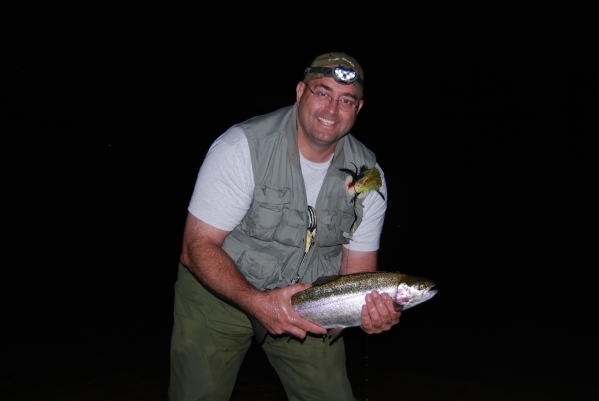Biologists work to restore Comins Lake as trout haven

Whenever you travel somewhere to fish for the first time, it is always a good idea to get intel from one of the locals. Of course, you never know how good that information is until you hit the water and put it to the test.
Sometimes the locals will tell the truth, and sometimes they will do what they can to protect their favorite fishing hole. That is where science meets the fishing realm, and experimentation proves which side of the truth fence your information source was standing on when he gave you the skinny.
Several years ago, I dropped by Sportsworld, a sporting goods store in Ely. I asked the older gentleman behind the counter for some fresh intel on Comins Lake, then Nevada’s top stillwater trout fishery. To my surprise, he not only told me what fly patterns to use, but also took the time to draw a map showing where I should launch my float tube. He included a quick lesson on how to fish a specific section of submerged weed beds.
Armed with this information, I made my way to Comins Lake and found the launch area the old gentleman drew on the map. In the water was the band of submerged vegetation just like he said. So far so good. Then I tied on a No. 12 Prince Nymph and kicked my float tube toward the weed bed. The experiment was underway.
Minutes later, something hammered my fly. I set the hook, and my rod tip bent over hard as the fish made run after run. After a battle of unexpected duration, I reeled in a heavy rainbow trout in the 23-inch range. The old gentleman’s intel was spot on.
At that time, Comins was a trout destination of international renown. Anglers came not only from around the Southwest but from points around the globe to fish for its large rainbow and German brown trout. Five-pound fish were commonplace. The lake record rainbow is 7 pounds, 2 ounces, and the lake’s best brown trout weighed 13 pounds, 8 ounces while measuring almost 30 inches.
Unfortunately, things were in the works that soon would destroy this tremendous fishery and have a significant impact on the local economy. Someone looking to catch something with a toothier grin illegally planted northern pike in 1999, biologists determined.
While the lake’s insect population was enough to help trout grow as much as 2 inches per month, it was not sufficient for fast-growing and hungry pike. The voracious predator did what predators do and began feeding on trout. While the protein helped the pike grow to lengths passing 40 inches, the trout population could not absorb the hit. It wasn’t long before the trout population was completely destroyed, along with most of the largemouth bass.
As the trout population diminished, so, too, did the number of anglers visiting Ely and injecting money into the economy. While there were those anglers who came looking for their chance to catch a lengthy pike, it wasn’t the same as before. Then, without a sufficient source of protein, the pike population crashed as well.
According to the Nevada Department of Wildlife, Comins averaged about 35,000 angler days a year in 2004. “This pumped more than $2,000,000 into the White Pine County economy. With the destruction of the fishery by 2013, angler visitation to Comins had dropped to less than 1,300 angler use days a year.”
In an effort to reclaim Comins’ status as a world-class trout fishery, state fisheries biologists are taking steps to rid the lake of pike. They also are looking to eliminate the pike from a small body of water called Bassett Lake, the possible source of pike in 1999. Plans call for the biologists to use rotenone, a naturally occurring substance that limits the ability of a fish to absorb oxygen through its gills. It has no effect on mammals or birds.
The Utah Division of Wildlife resources has used this same approach to restoring Panguitch Lake after illegal introductions of Utah chub have all but destroyed the trout fishery there.
NDOW plans to follow the rotenone treatment with trout plants in Comins this fall and bass plants in Bassett Lake next spring. Though it will take awhile for Comins to come back to its full glory, we can look forward to catching some nice fish as early as next spring.
Freelance writer Doug Nielsen is a conservation educator for the Nevada Department of Wildlife. His “In the Outdoors” column, published Thursday in the Las Vegas Review-Journal, is not affiliated with or endorsed by the NDOW. Any opinions he states in his column are his own. He can be reached at intheoutdoorslv@gmail.com.